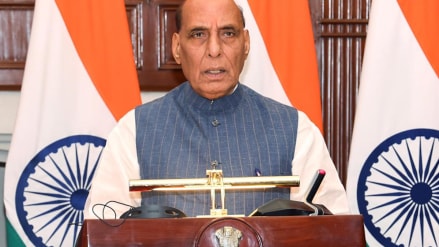At the Border Area Development Conclave held in New Delhi on September 11, 2024, Defence Minister Rajnath Singh reaffirmed the Indian government’s full commitment to the comprehensive development of border villages. Singh emphasized that these villages should not be seen as remote or isolated areas but as the country’s first line of strength, integral to national security and regional progress.
India’s geographical positioning presents unique challenges, with vast borders that require a strong strategic and developmental focus. Addressing these challenges, Singh stressed that the government’s approach is centered on integrating border areas with the rest of the country by enhancing infrastructure, improving connectivity, and promoting tourism. The development of border regions, according to the defence minister, is a crucial strategy not just for military preparedness but also for the upliftment of the local population.
Infrastructure: A Foundation for Progress
Singh highlighted the remarkable progress achieved in border infrastructure over the past decade, specifically crediting the Border Roads Organisation (BRO) for constructing over 8,500 kilometers of roads and more than 400 permanent bridges in border areas. Notable projects such as the Atal Tunnel, Sela Tunnel, and the upcoming Shinkun-La Tunnel, set to be the world’s highest, represent significant milestones. These infrastructure developments enhance military mobility in sensitive regions and create pathways for civilian access, empowering communities that were once isolated.
In addition to roadways, Singh pointed to the government’s efforts to enhance electricity and internet connectivity in these areas. The 220 Kilo-Volt Srinagar-Leh electricity line has connected Ladakh to the national grid, while the Bharat-Net broadband project has provided high-speed internet to over 1,500 villages. Singh noted that more than 7,000 villages in border regions have gained internet access in the past four years alone, with a special focus on Ladakh and Arunachal Pradesh. These initiatives are part of a broader mission to ensure that border areas receive the same access to essential services as the rest of the country.
Economic Development and Tourism: Catalysts for Growth
Tourism is being positioned as a key driver of economic growth in border regions, with Singh citing a 30% increase in tourist footfall in areas such as Ladakh, Sikkim, and Arunachal Pradesh between 2020 and 2023. This rise in tourism has not only boosted local economies but also created jobs, reducing unemployment and curbing outmigration from these areas. Jammu & Kashmir, a region with tremendous tourism potential, has also witnessed a significant uptick in visitors, thanks to improved security and infrastructure.
The government’s Vibrant Village program, which aims to transform border villages into model communities, is a cornerstone of this effort. Singh highlighted that the initiative is focused on Uttarakhand, Himachal Pradesh, and Arunachal Pradesh, regions that have long struggled with limited connectivity and infrastructure. By fostering development in these areas, the government is working to reverse the trend of migration and encourage people to return to their native villages—a phenomenon Singh described as “reverse migration.”
Huri village in Arunachal Pradesh was highlighted as a success story of civil-military collaboration, where coordinated efforts between the government, the Indian Army, and BRO have spurred development and encouraged residents to return. Singh noted that this model of collaboration could serve as a template for similar efforts in other border regions.
Civil-Military Collaboration: A Strategic Pillar
Throughout the conclave, the importance of civil-military cooperation in the development of border areas was repeatedly emphasized. Chief of the Army Staff General Upendra Dwivedi, who also addressed the conclave, described the development of border areas as a core component of national security. He highlighted the Indian Army’s vital role in building infrastructure, providing medical and disaster relief, and supporting humanitarian efforts in border regions.
General Dwivedi also stressed that infrastructure development, smart border management, and economic empowerment of local communities are essential pillars of the government’s border area development vision. The Indian Army, through its constant presence in these regions, has been instrumental in bridging the gap between civilian governance and security needs. Schools run by the Indian Army, the promotion of youth participation through the National Cadet Corps (NCC), and efforts to provide skills and education to the next generation have been central to these efforts.
